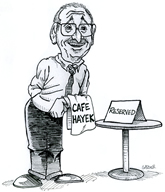This week, [Japan’s Prime Minister Shigeru] Ishiba was again first in line — but not in a good way. He became the first foreign leader to receive a scathing letter from the U.S. president, threatening steep new tariffs if Tokyo didn’t meet Trump’s new deadline for a trade deal.
The letter stunned some officials in Japan, a security ally for seven decades and a key partner in U.S. efforts to counter an increasingly assertive China.
Ronald Reagan deserves much praise for his stalwart commitment to free trade and lowering trade barriers.
Even his most contentious policy—the Voluntary Export Restraint (VER) agreement with Japan—can be seen as a defense of free trade, once the context and Reagan’s limited options are understood.
…..
In fact, the Big Three did not even want the import restrictions to begin with. Doug Irwin writes, “GM, Ford, and Chrysler did not want to restrict imports because they themselves had begun importing foreign produced cars under their own nameplate. In 1975, the UAW charged twenty-eight foreign auto manufacturers in eight countries with dumping, but domestic producers did not support the petition because 40 percent of imported cars came from their subsidiaries.”
But what about the increased foreign investment, particularly in the American South? Surely, while Detroit struggled, carmakers like Honda and Toyota, who started to build plants in the US and thus avoid the export restraint restrictions, right?
Wrong.
First, it would be silly to imagine that a temporary, voluntary restraint on exporting goods into the US would impel Japanese auto firms to invest millions of dollars into building assembly plants and the necessary infrastructure to make these plants operational.
Volkswagen began building manufacturing plants in Pennsylvania in 1978 and Honda built its first plant in Ohio in 1979, two years before the VER, building motorcycles. Seeing their successes, Honda then announced more plants being built in 1980, which began opening from 1982 to 1986. Why is this?
According to a 1990 report by the Philadelphia Federal Reserve, Japanese auto firms producing in the US made economic sense.
…..
In fact, if we look at the data, we see about $652 million of foreign direct investment in 1981 versus $5.3 billion in 1994 when the VER ended. In other words, a 700 percent increase in foreign investment. That sounds like a lot until we see that from the increase from 1994-1999: a 770 percent increase in just five years as compared to the fourteen years of the VER, increasing foreign investment in the US auto sector from $5.3 billion to a staggering $46.1 billion.
If anything, what this suggests is that it was trade liberalization, not protectionism, that spurred foreign investment.
…..
Like almost all of [Oren] Cass’s insights into history and economics, he finds a kernel of truth and builds an elaborate monstrosity of an argument on top of it relying on revisionist history and fallacious post hoc reasoning. The simple truth is that the VER that Japan negotiated did not lead to increased foreign investment in the United States beyond what was announced years prior to the VER even being considered. In fact, foreign investment in the United States increased dramatically when VER was rescinded, not while it was in effect.
Critics claim that portable benefits encourage employers to mislabel workers as independent contractors. Available evidence doesn’t back this up. In Utah, where a portable benefits policy took effect in 2023, traditional W-2 employment and self-employment continued to grow at similar rates as before. The policy merely allowed independent workers to access benefits. Even in California and Massachusetts — which have the country’s strictest misclassification laws, in the name of worker protection — the presence of benefits isn’t part of the classification test. That should reassure skeptics.
There is another obvious reason why portable benefits are gaining traction: Early responses to the challenges posed by the gig economy’s growth have led to disappointing results.
In California, lawmakers implemented an “ABC test,” which presumes that workers are employees unless they meet a strict legal threshold for independent self-employment. It backfired. Overall employment declined by 4.4 percent on average in affected occupations, with no corresponding increase in W-2 jobs. The law has since been partially rolled back, and more than 100 occupations (e.g., musician, translator, editor) are now exempt from it. A broader analysis by my research team confirms this trend: In states that adopt ABC tests, traditional W-2 employment declines by an astounding 4.8 percent. Self-employment drops even further, by 6.5 percent.
The real issue is that most independent workers don’t want to be reclassified as employees. They’re asking for a system that reflects how they actually work — one that offers support without forcing them into a one-size-fits-all model.
Bill Kristol has had a change of heart. He is now opposed to the president sending alleged foreign enemies to rot in overseas prisons, and the claims of expansive executive powers and sprawling homeland security bureaucracy that enables him to do so.
Walter Olson is correct: “The First Amendment protects ideologically based ad boycotts.”



